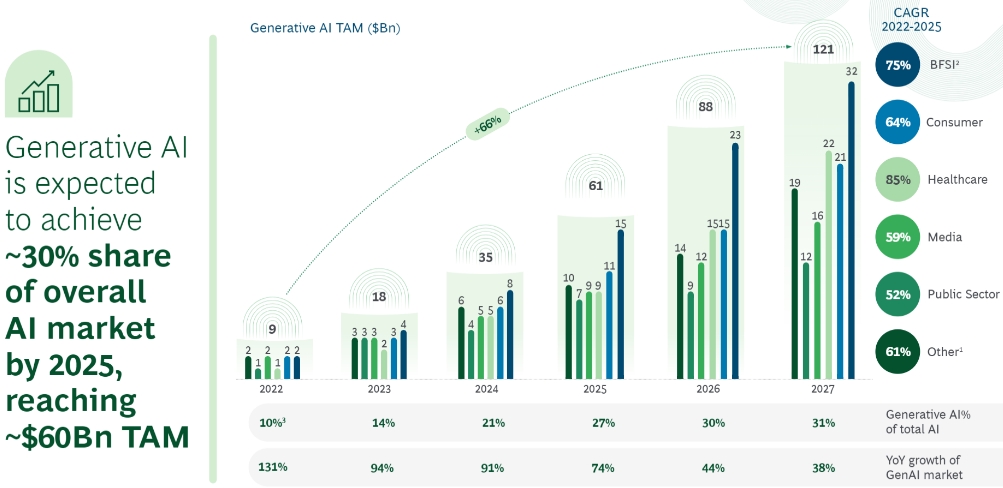Note:
1. Other includes Industrial Goods, Energy, and Telecom markets;
2. BFSI includes Insurance (~$2Bn 2025) and Financial Institutions (~$13Bn 2025) including retail and wholesale banking, asset and wealth management, and private equity Sources: AI TAM research, Expert interviews, BCG analysis
Source: Architects of Change: Generative AI’s Role in Revolutionizing IT Services (BCG)
Unlike one-size-fits-all automation, Gen AI necessitates iterative refinement to align with the complexities of banking processes. For instance, consider a bank's attempts to optimize fraud detection using Gen AI. It's not merely about implementing the technology; it's about crafting a fine-tuned solution that learns from historical data, adapts to new fraud patterns, and consistently enhances its accuracy. The journey to optimize outcomes is a continuous loop of observation, analysis, and enhancement.
- Regulatory Requirements and Decision Explain-ability
The banking landscape is governed by stringent regulations demanding transparency in decision-making. Gen AI's power must be leveraged while ensuring that decisions made by these models remain comprehensible, a difficult task that necessitates unearthing the path to a transparent decision-making process. - Computing Power and Data Accessibility
The Gen AI journey isn't without computational demands. The sheer scale and complexity of training Gen AI models require substantial computing power. Banks must forge robust partnerships with cloud providers to accommodate these computational requirements and evaluate the ensuing cost implications. - Legal and Regulatory Uncertainties
As a nascent technology, Gen AI operates in a landscape with blurred regulatory boundaries. Questions of data security, privacy, and potential legal pitfalls hover in the horizon. The unchartered territory of Gen AI demands cautious navigation through dynamic legal frameworks. - Specialized Skillset and Talent Gap
Gen AI demands specialized skillset to navigate its intricacies. The demand for Gen AI talent surpasses its availability, creating skills gap that banks must bridge to harness its transformative potential fully. - Addressing Human Biases and Data Governance
As Gen AI learns from historical data, it inherits the biases present within. Banks must ensure that these biases are identified, addressed, and neutralized. Establishing data governance frameworks becomes a non-negotiable imperative to ensure ethical and unbiased Gen AI implementation.
In the face of these challenges lies a vista of opportunity – an opportunity to innovate, redefine operational paradigms, and craft a banking future that balances risk with caution.
Paving the Way for Transformation
The integration of Generative AI offers not only obstacles, but also a gateway to substantial growth. As financial institutions navigate the complexities of Gen AI, they are poised to capitalize on crucial opportunities that lie at the crossroads of innovation and caution.
- Leveraging Generative AI's Adaptability and Problem-Solving
Generative AI's potential lies in its unparalleled adaptability and creative problem-solving ability. Unlike traditional automation solutions confined by pre-set rules, Gen AI operates in a realm of boundless possibilities. It excels in unstructured domains, simplifying difficult problems where other technologies fail. Whether deciphering complex customer queries or optimizing trading strategies, Gen AI shines in scenarios that demand creative insights and unconventional thinking. This inherent flexibility isn't just a response to challenges; it's an opportunity for banks to infuse their operations with the dynamism needed to outplay uncertainty. - Responsible and Cautious Adoption for Mitigating Risk
Responsible adoption entails meticulous calibration, transparent communication, and the creation of checks and balances. It's about acknowledging the power of Gen AI while being vigilant against potential pitfalls. A cautious approach implies understanding the technology's limitations, foreseeing potential biases, and architecting safeguards against unintended outcomes. The opportunity here isn't just about adopting Gen AI; it's about fostering an environment where innovation is underpinned by ethical considerations, where transformation walks hand in hand with resilience.
Generative AI Transforming Financial Services
The transformational impact of Gen AI is evidenced across various facets of financial services. From personalized customer support through advanced chatbots to algorithmic trading's ability to capitalize on market inefficiencies, Gen AI's reach is vast and varied.
- Customer Support and Chatbots
Gen AI's emergence has unlocked new dimensions in customer service. Personalized assistance and account management have transcended conventional norms, now empowered by AI-driven chatbots. These virtual assistants understand customer queries, provide tailored recommendations, and effortlessly manage tasks such as balance inquiries. The result is superior customer experiences that foster loyalty and satisfaction. - Algorithmic Trading
The world of trading has witnessed a tectonic shift with the infusion of Generative AI. Real-time trading decisions, once dependent on human capabilities, are now guided by AI algorithms that excel in capitalizing on market inefficiencies. Through meticulous analysis of vast market data, these algorithms identify patterns, anticipate trends, and execute trades with precision, driving unparalleled performance. - Portfolio Optimization
Drawing from historical market data and economic indicators, Gen AI crafts investment portfolios with meticulous precision. Tailored to individual preferences, risk tolerance, and prevailing market conditions, it proposes optimal asset allocations and investment strategies, empowering investors with informed choices. - Credit Scoring and Underwriting
Gen AI’s analytical capabilities dissect credit histories, financial statements, and alternative data sources to assess creditworthiness. The result is enhanced credit scoring accuracy, streamlining underwriting processes and propelling lending efficiency. - Risk Assessment
Gen AI's analytical capabilities dissects extensive data, ranging from market trends to customer behaviors and economic indicators. The outcome is informed risk assessments for investments, loans, and insurance, empowering institutions to make calculated decisions with foresight. - Fraud Detection
By dissecting transaction patterns and learning from historical data, Gen AI identifies anomalies and prevents fraudulent activities proactively. The power of Gen AI lies in its ability to shield financial institutions and customers alike from threats before they materialize.
Strategies for Responsible Adoption of Generative AI
As financial institutions embark on the journey of Gen AI integration, the following three pivotal pillars have the strength to ensure an ecosystem that's robust, transparent, and aligned with the highest standards:
- Collaborating with Experienced Partner
The roadmap to Gen AI integration starts with forging partnerships that bring expertise to the fore. Collaboration with seasoned partners usher in a wealth of knowledge, a compass that steers the adoption process toward responsible implementation. The insight of industry experts ensures that the Gen AI journey is traversed with precision, safeguarding against pitfalls and maximizing benefits. - Establishing Data Governance Frameworks
Responsible Gen AI adoption hinges on the establishment of rigorous data governance frameworks. As data becomes the cornerstone of AI-driven decisions, these frameworks ensure the sanctity of information. They meticulously address potential biases and pitfalls that can seep into AI models. It's not just about enhancing security; it's about upholding ethics and transparency, creating a shield against unintended consequences. - Custom Foundation Model vs. Subscription: A Strategic Choice
Customization offers alignment with specific banking needs, but requires substantial resources. Subscription models, on the other hand, expedite integration but require careful evaluation to ensure compatibility. It's a strategic choice, a choice that needs to be grounded in the institution's goals, capabilities, and timeline.
The Path Forward
As financial institutions tread the path of responsible Gen AI adoption, it's a declaration of commitment—a commitment to fostering innovation that's guided by strategy, a commitment to infusing the industry with transformative technology that's underpinned by ethics. This path is no longer a choice; it's a necessity, a necessity that ensures a banking landscape where progress is measured not just by technological leaps, but by the ethics and caution that accompany them.






